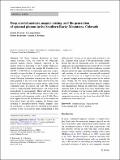Deep crustal anatexis, magma mixing, and the generation of epizonal plutons in the Southern Rocky Mountains, Colorado
Author(s)
Jacob, Kristin H.; Farmer, G. Lang; Buchwaldt, Robert; Bowring, Samuel A.
Download410_2014_Article_1094.pdf (7.279Mb)
OPEN_ACCESS_POLICY
Open Access Policy
Creative Commons Attribution-Noncommercial-Share Alike
Terms of use
Metadata
Show full item recordAbstract
The Never Summer Mountains in north-central Colorado, USA, are cored by two Oligocene, epizonal granitic plutons originally emplaced in the shallow levels of a short-lived (~1 m.y.), small-volume continental magmatic system. The younger Mt. Cumulus stock (28.015 ± 0.012 Ma) is a syenogranite equivalent compositionally to topaz rhyolites. A comparison to the chemical and isotopic composition of crustal xenoliths entrained in nearby Devonian kimberlites demonstrates that the silicic melts parental to the stock were likely derived from anatexis of local Paleoproterozoic, garnet-absent, mafic lower continental crust. In contrast, the older Mt. Richthofen stock is compositionally heterogeneous and ranges from monzodiorite to monzogranite. Major and trace element abundances and Sr, Nd and Pb isotopic ratios in this stock vary regularly with increasing whole rock wt% SiO2. These data suggest that the Mt. Richthofen stock was constructed from mixed mafic and felsic magmas, the former corresponding to lithosphere-derived basaltic magmas similar isotopically to mafic enclaves entrained in the eastern portions of the stock and the latter corresponding to less differentiated versions of the silicic melts parental to the Mt. Cumulus stock. Zircon U–Pb geochronology further reveals that the Mt. Richthofen stock was incrementally emplaced over a time interval from at least 28.975 ± 0.020 to 28.742 ± 0.053 Ma. Magma mixing could have occurred either in situ in the upper crust during basaltic underplating and remelting of an antecedent, incrementally emplaced, silicic intrusive body, or at depth in the lower crust prior to periodic magma ascent and emplacement in the shallow crust. Overall, the two stocks demonstrate that magmatism associated with the Never Summer igneous complex was fundamentally bimodal in composition. Highly silicic anatectic melts of the mafic lower crust and basaltic, mantle-derived magmas were the primary melts in the magma system, with mixing of the two producing intermediate composition magmas such as those from which Mt. Richthofen stock was constructed.
Date issued
2015-01Department
Massachusetts Institute of Technology. Department of Earth, Atmospheric, and Planetary SciencesJournal
Contributions to Mineralogy and Petrology
Publisher
Springer Berlin Heidelberg
Citation
Jacob, Kristin H. et al. “Deep Crustal Anatexis, Magma Mixing, and the Generation of Epizonal Plutons in the Southern Rocky Mountains, Colorado.” Contributions to Mineralogy and Petrology 169.1 (2015): n. pag.
Version: Author's final manuscript
ISSN
0010-7999
1432-0967